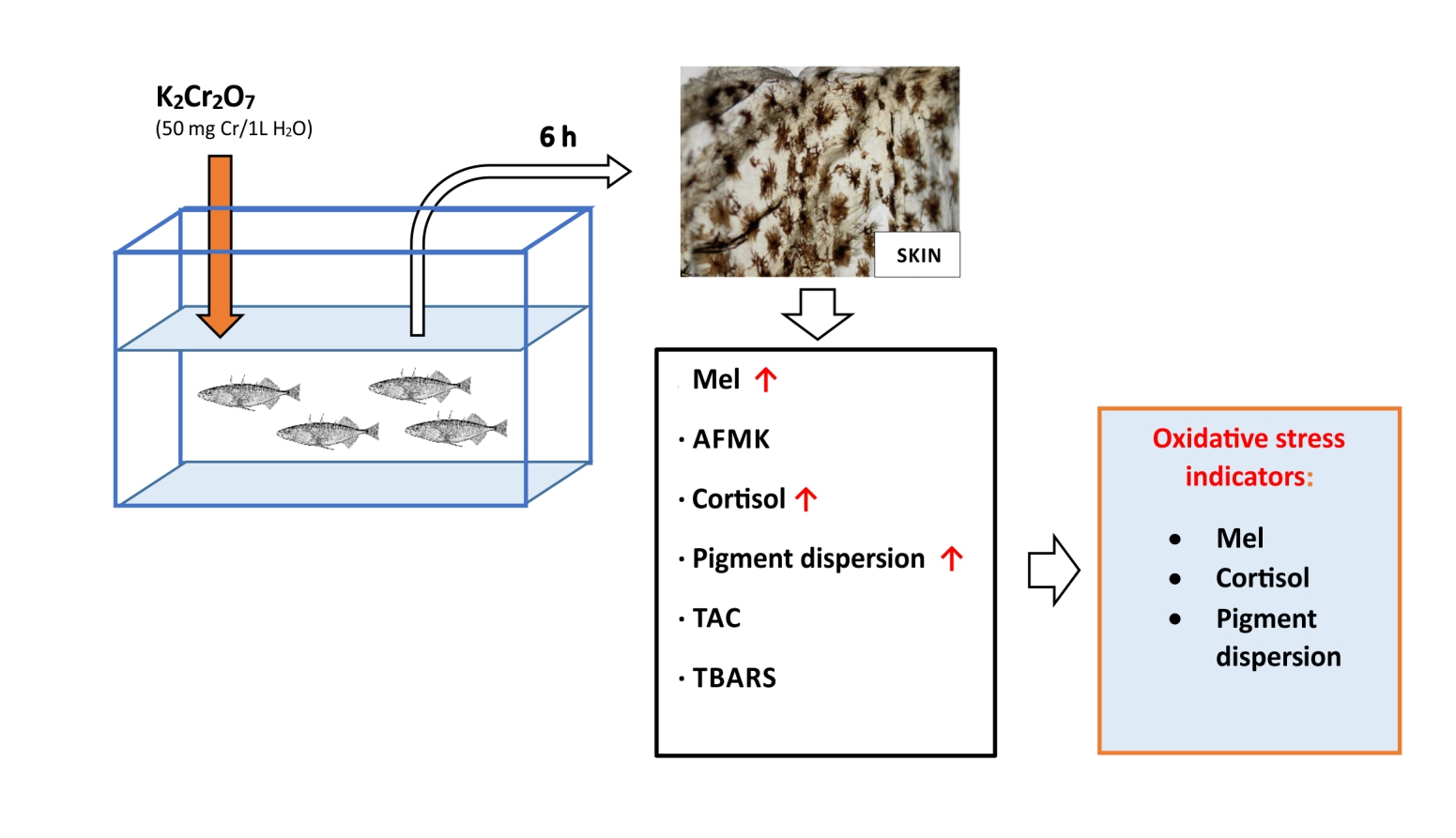A few words on the project “Fish under stress - cutaneous stress response system - how does it work?”
The skin of vertebrates is a well-known biological barrier that defends the organism against harmful environmental factors; the skin also mediates the exchange of information between the internal and external environment to maintain the dynamic equilibrium in an organism.
This research aims to answer the question (on the example of two Baltic Sea species: the three-spined stickleback and European flounder): How does the cutaneous stress response system work in teleost fish subjected to oxidative stress in the laboratory? In the experiments, we use potassium dichromate added to aquarium water as an oxidant that evokes oxidative stress.
Based on our experience and literature, we assumed that melatonin (Mel), its derivative AFMK, the stress hormone cortisol, and other factors that protect cells from oxidative stress in fish skin make a consistent cutaneous stress response system. In this study, we wanted to know
- How oxidative stress affects:
- Mel biosynthesis (including gene expression of enzymes of the Mel biosynthesis pathway),
- AFMK formation in the skin,
- pigment dispersion in melanophores?
- Is there a relationship between the levels of melatonin, AFMK, and cortisol, and TBARS and TAC (indicators of oxidative stress) in the skin?
This project extends the previous one (project NCN “Stress hormones in fish skin” in 2012-2017). We then demonstrated for the first time that there are hints that a cutaneous stress response system exists in fish. Then we analyzed only flounder skin fragments exposed in vitro to cortisol in doses that mimic stress conditions, but we did not perform any experiment with fish subjected to stress. We showed that cortisol affects Mel and AFMK release from flounder skin fragments in a dose-dependent manner. Moreover, we found that it is probable that Mel and AFMK are generated in the skin. Although the research strongly suggested that the cutaneous stress response system is present in fish, one crucial question was left unanswered: How does this system work in fish subjected to stress?
In the current study (project NCN “Fish under stress - cutaneous stress response system - how does it work?”), we expect to find the answer.

|
List of the relevant papers
- Gozdowska M., Stoń-Egiert J., Kulczykowska E. 2024. Short communication: An alternative pathway for melatonin synthesis in the skin of European flounder (Platichthys flesus). Comp. Biochem. Physiol. Part A, 297:111731. (doi.org/10.1016/j.cbpa.2024.111731) (PDF - 776 KB)
- Sokołowska E., Kulczykowska E. 2024. A new insight into the pigmentation of the three-spined stickleback exposed to oxidative stress: day and night study. Front. Mar. Sci. 11:1401537.(doi: 10.3389/fmars.2024.1401537) (PDF - 541 KB)
- Pomianowski K., Gozdowska M, Sokołowska E., Kulczykowska E. 2023. The cutaneous stress response system in three-spined stickleback and European flounder exposed to oxidative stress: Different mode of action. Comp. Biochem. Physiol. Part A, 285:111493. (doi.org/10.1016/j.cbpa.2023.111493) (PDF - 3.27 Mb)
- Gozdowska M., Sokołowska E., Pomianowski K., Kulczykowska E. 2022. Melatonin and cortisol as components of the cutaneous stress response system in fish: Response to oxidative stress. Comp. Biochem. Physiol. Part A, 268:111207. (PDF - 2.45 Mb)
- Pomianowski K., Burzyński A., Kulczykowska E. 2021. A de novo Transcriptome Assembly of the European Flounder (Platichthys flesus): The Preselection of Transcripts Encoding Active Forms of Enzymes. Front. Mar. Sci. 8:618779. (PDF - 250 kb)
- Pomianowski K., Gozdowska M., Burzyński A., Kalamarz-Kubiak H., Sokołowska E., Kijewska A., Kulczykowska E. 2020. A study of aanat and asmt expression in the three-spined stickleback eye and skin: Not only "on the way to melatonin". Comp. Biochem. Physiol. Part A, 241: 110635. (PDF - 0.65 Mb)
- Ewa Kulczykowska. 2019. Stress Response System in the Fish Skin - Welfare Measures Revisited. Front. Physiol. 10:72. (PDF - 160 kb)
- Kulczykowska E., Kalamarz-Kubiak H., Gozdowska M., Sokołowska E. 2018. Cortisol and melatonin in the cutaneous stress response system of fish. Comparative Biochemistry and Physiology, Part A 218, 1-7. (PDF - 1.2 Mb)
- Kulczykowska E., Kleszczyńska A., Gozdowska M., Sokołowska E., 2017. The time enzyme in melatonin biosynthesis in fish: Day/night expressions of three aralkylamine N-acetyltransferase genes in three-spined stickleback. Comparative Biochemistry and Physiology, Part A 208, 46-53 (PDF - 1.1 Mb) (Corrigendum to paper - PDF)